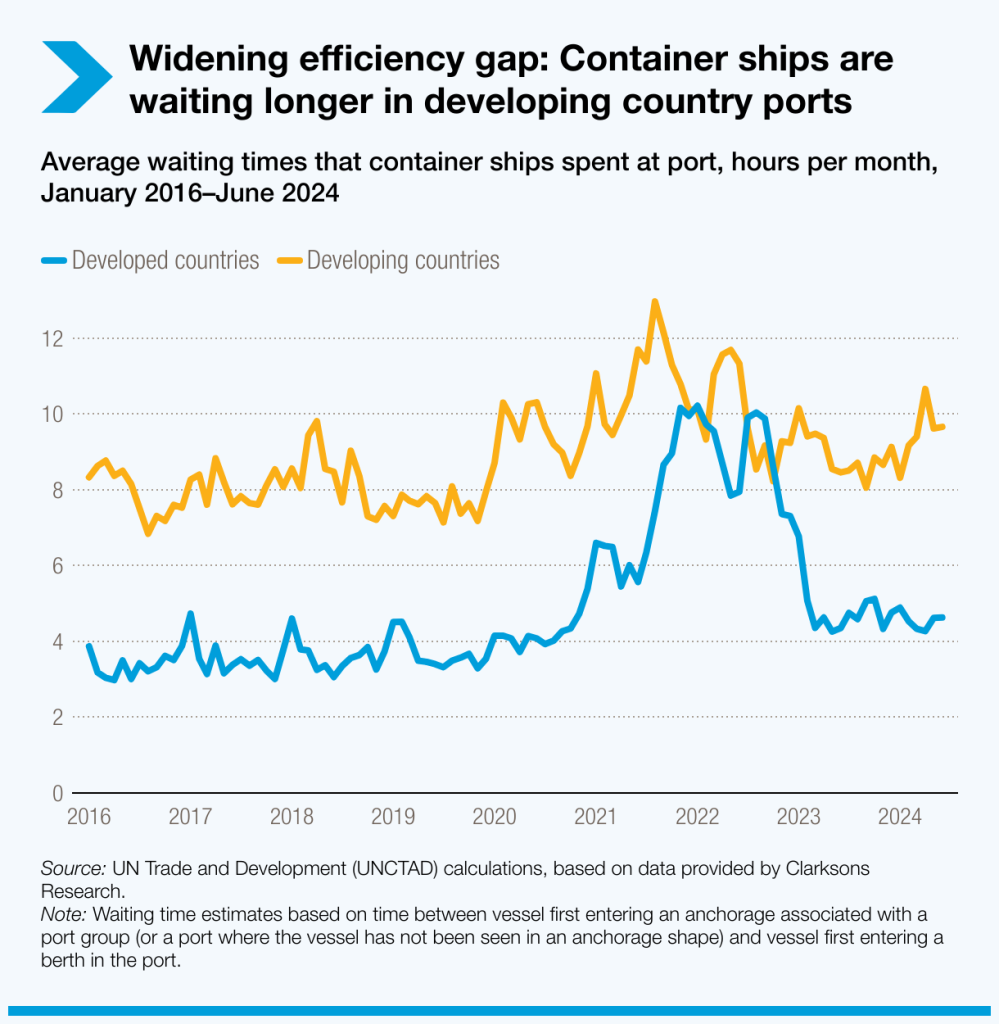How to optimize port calls?
Have a question on how to approach waste and risks in ports? Find the answer here.
Port calls are complex, involving many stakeholders, siloed data, and constant change, all of which create delays and inefficiencies. Optimization means shifting from reactive decisions to proactive, data-driven collaboration. This improves reliability, reduces waste, and supports decarbonization goals.
Port call delays often stem from a lack of visibility and coordination across critical services and operations. At its core, a port call involves a vessel visiting a berth, but behind that seemingly simple process lies a complex chain of events that can disrupt planning and execution.
In UNCTAD's recent maritime report, there has been a widening gap in efficiency of port in developing countries - these ports are reporting longer waiting time.

Key reasons for delays include:
Unclear or changing ETA/ETD schedules: Limited access to real-time planning data causes uncertainty.
Service availability gaps: Delays often result from uncoordinated arrival of essential services like tugs, boatmen, and pilots.
Bunker operations misalignment: In busy ports, bunkering can significantly extend a vessel’s stay. If the bunker vessel is late or poorly scheduled relative to cargo operations, the entire turnaround suffers.
Port call optimization is the process of improving the efficiency, predictability, and collaboration across every phase of a vessel's visit to a port - from anchorage to departure.
Traditionally, port performance is measured by the time a vessel spends alongside the berth (from first line to last line). But this overlooks significant delays and inefficiencies occurring before and after, like waiting at anchorage, navigating in, or delays during departure. These periods often go unmanaged and unoptimized.
Teqplay believes that port call optimization should expand the focus beyond the berth, considering the full vessel journey through the port:
Waiting time at anchorage
Nautical services coordination (pilots, tugs, boatmen)
Berthing and unberthing
Cargo operations and bunker scheduling
Departure clearance and outbound transit
Just-in-time (JIT) arrival is not just a dream, but it’s not a one-size-fits-all solution either. In reality, achieving true JIT in port operations depends on localized context, real-time data, and deep collaboration between all stakeholders.
While the concept of JIT has long been viewed as an industry ideal, the complexity behind each port call makes global, all-in-one solutions impractical. Every JIT scenario depends on:
The specific terminal and its operations
The vessel and its cargo status
Local conditions, such as weather or berth congestion
Dynamic interactions between sea-based and land-based actors
Instead of relying on a single system, JIT requires interoperable solutions and collaborative alignment. It's about matching two key variables:
Estimated Time of Arrival (ETA) of the vessel
Planned Time of Berth Availability at the terminal
Discrepancies between these times are common, and closing that gap is where collaboration becomes critical. Terminal operations, weather events, navigational challenges, and even market-driven cargo decisions can impact timelines.
Decarbonization has become a driving force for transformation in the maritime industry, pushing stakeholders to improve efficiency, resilience, and collaboration across the supply chain.
While it’s rooted in urgent climate challenges, the decarbonization mandate is proving to be a blessing in disguise. It’s not just an environmental imperative, it’s a legal and strategic one. Regulations and emissions targets, especially those addressing Scope 3 emissions, are forcing companies to go beyond operational silos and reimagine how they work together.
Key impacts include:
Mandatory collaboration: Reducing emissions requires coordination across terminals, liners, agents, and port authorities.
Data transparency: Sharing operational data is now essential for building emissions accountability.
Process optimization: Efficiency is no longer optional. Delays, fuel waste, and reactive planning now carry both financial and environmental costs.
Climate resilience: More extreme weather and rising sea levels make it critical for operators to use real-time data and forecasts to adapt decisions on the fly.
Reducing waste and boosting efficiency in port operations is a multi-step, collaborative journey - one that requires visibility, trust, and actionable data. At Teqplay, we break it down into three fundamental phases: Expose, Address, and Eliminate waste.
1. Expose Waste
The first step is building awareness. Many inefficiencies in port calls are hidden in routine operations: idle time at anchorage, service delays, or misalignments between stakeholders.
Use real-time data to uncover hidden time, cost, and emissions impacts.
Extend analysis beyond “first line to last line” and include all phases: sailing in, waiting, bunkering, cargo ops, sailing out.
Create urgency by quantifying the financial and contractual implications of waste.
Goal: Make inefficiencies visible and measurable.
2. Address Waste
Once waste is identified, it’s time to investigate why it happens and where to act.
Engage all involved actors: terminals, liners, port authorities, nautical service providers.
Map out responsibilities, processes, and pain points collaboratively.
Ensure a neutral and trusted data foundation to eliminate bias and focus the conversation on shared facts.
Understand which delays are “good” (strategic buffer) versus “bad” (avoidable waste).
Goal: Align stakeholders around shared problems and improvement priorities.
3. Eliminate Waste
This phase turns insight into action.
Implement sustainable improvements, from tech integrations to new collaboration protocols.
Set up performance metrics (e.g., port turnaround time).
Foster a culture of continuous improvement with feedback loops and cross-party transparency.
Goal: Systematically remove unproductive time, reduce emissions, and increase predictability.
